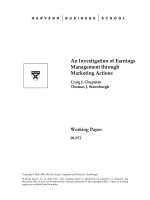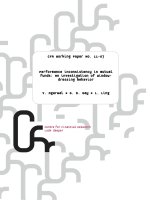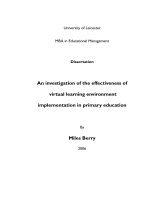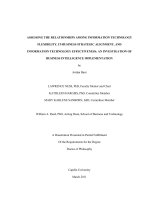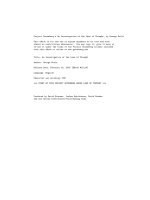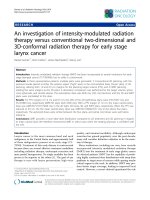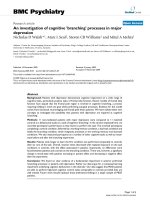An investigation of broadband antennas
Bạn đang xem bản rút gọn của tài liệu. Xem và tải ngay bản đầy đủ của tài liệu tại đây (3.77 MB, 139 trang )
AN INVESTIGATION OF BROADBAND ANTENNAS
THAM JING-YAO
(B. Eng. (Hons) NUS)
A THESIS SUBMITTED
FOR THE DEGREE OF MASTER OF ENGINEERING
DEPARTMENT OF ELECTRICAL & COMPUTER ENGINEERING
NATIONAL UNIVERSITY OF SINGAPORE
2005
To My Family
i
Acknowledgements
I would like to express my utmost gratitude to my project supervisor Associate
Professor Ooi Ban Leong, for being so approachable and his numerous suggestions on
my research.
I would like to express my sincere thanks to my other project supervisor Professor
Leong Mook Seng, for being extremely supportive of my decision to embark in this
fulfilling journey of learning about microwaves, and getting to know so much more
about our physical world.
I would like to thank all the staff of RF/Microwave laboratory and ECE
department, especially Mr. Sing Cheng Hiong, Mr. Teo Tham Chai, Mdm Lee Siew
Choo, Ms Guo Lin, Mr. Hui So Chi and Mr. Chan for their very professional help in
fabrication, measurement and other technical and administrative support.
In addition, all my friends around me played a no less important role in making
my research life much more enjoyable. Fan Yijing is my most loyal companion,
having gone through thick and thin with me.
Ng Tiong Huat has a sea of knowledge
and experience, which he does not hesitate to share with me.
Zhang Yaqiong is a
great friend whom I always had engaging conversations with.
interesting emails Ewe Wei Bin sent always lightened my day.
The numerous
I would like to thank
all of them, and all other friends I got to know along the way – for being there.
ii
Table of Contents
Acknowledgements .......................................................................................................ii
Table of Contents .........................................................................................................iii
List of Figures................................................................................................................ v
List of Tables...............................................................................................................viii
List of Symbols ............................................................................................................. ix
Summary........................................................................................................................ x
Chapter 1 Introduction................................................................................................. 1
1.1
Objectives ................................................................................................... 3
1.2
Organisation of Thesis ................................................................................ 4
1.3
Original Contributions ................................................................................ 5
Chapter 2 Broadband Antennas .................................................................................. 7
2.1
Frequency Independent Antennas ............................................................... 8
2.2
Ultra Wideband Antennas ......................................................................... 11
Chapter 3 Novel Planar Volcano-Smoke Antennas.................................................. 17
3.1
A simple and quick synthesis method for the Volcano-Smoke Slot Antenna
................................................................................................................... 18
3.1.1
Formulation............................................................................................. 19
3.1.2
Numerical Solution ................................................................................. 24
3.2
Novel Modifications to the slot of PVSA ................................................. 35
3.2.1
T-shaped Protrusions on the slot of PVSA.............................................. 35
3.2.2
Serpentine slot PVSA ............................................................................. 43
3.2.3
Diamond-Shaped Antenna ...................................................................... 47
3.3
Discussions ............................................................................................... 53
Chapter 4 A Mixed Dielectric LTCC Broadband Coplanar P-shaped Antenna ... 55
4.1
Antenna Structure ..................................................................................... 57
4.2
Parametric Study ....................................................................................... 59
4.2
Design Procedure ...................................................................................... 66
4.3
Experimental Results and Discussions ..................................................... 71
4.4
Analysis..................................................................................................... 87
4.5
Conclusion ................................................................................................ 91
Chapter 5 Conclusions and Future Works ............................................................... 92
5.1
Conclusion ................................................................................................ 92
5.2
Future Works............................................................................................. 96
5.2.1
Improving the bandwidth of the P-shaped slot antenna.......................... 96
5.2.2
Improving the analysis method of the P-shaped slot antenna................. 99
5.2.3
Investigation of other possible UWB antennas..................................... 100
5.2.3.1 The Novel Log-periodic Antenna ........................................................... 102
References .................................................................................................................. 119
Appendix A Full derivation of the reflection coefficient as a function of distance
..................................................................................................................................... 119
iii
Appendix B Matlab scripts for solving input impedance of planar volcano-smoke
slot antenna................................................................................................................ 122
B.1
Main ...................................................................................................... 122
B.2
Characteristic Impedance of CPW........................................................ 124
B.3
Finding the curve of slot ....................................................................... 125
B.4
Differentiation of Z0 .............................................................................. 126
iv
List of Figures
Fig. 2.1
Fig. 2.2
Fig. 2.3
Fig. 3.1
Fig. 3.2
Fig. 3.3
Fig. 3.4
Fig. 3.5
Fig. 3.6
Fig. 3.7
Fig. 3.9
Fig. 3.10
Fig. 3.11
Fig. 3.12
Fig. 3.13
Fig. 3.14
Fig. 3.15
Fig. 3.16
Fig. 3.17
Fig. 3.18
Fig. 3.19
Fig. 3.20
Fig. 3.21
Fig. 3.22
Fig. 3.23
Fig. 3.24
Fig. 3.25
Fig. 3.26
Fig. 3.27
Fig. 3.28
Fig. 3.29
Fig. 3.30
Fig. 3.31
Equiangular spiral antenna .......................................................................... 10
Complementary structures........................................................................... 11
The S21 time-domain response to a Gaussian monocycle input signal on the
left (a) is for a log-periodic antenna while the S21 time domain response on
the right (b) is for a Vivaldi antenna [11] .................................................... 15
Volcano-smoke slot antenna ........................................................................ 20
Initial profile of the volcano-smoke slot antenna ........................................ 26
A(x) and B(x) profile................................................................................... 27
Variation of Characteristic Impedance with position .................................. 27
Graph of Input impedance against position................................................. 29
Design Flowchart......................................................................................... 30
Tuning process flowchart ............................................................................ 32
Measured S11-parameter of the PVSA ....................................................... 34
Geometry of the conventional PVSA ...................................................... 36
PVSA with T-shaped protrusions along the slot ...................................... 36
Simulated S11 characteristics of both antennas ....................................... 37
Measured S11 characteristics of both antennas ....................................... 38
Radiation patterns of the conventional PVSA at (a) 5 GHz, (b) 10 GHz 39
Radiation patterns of the modified antenna at (a) 5 GHz, (b) 9.5 GHz and (c)
13 GHz ..................................................................................................... 40
Gain of the T-slot PVSA and the conventional PVSA compared against the
isotropic antenna ...................................................................................... 41
Simulated return loss of the modified antennas for the different sizes of
“T”s .......................................................................................................... 42
Measured return loss of the modified antennas for the different sizes of
“T”s .......................................................................................................... 42
Various dimensions of the T-shaped protrusions of the PVSA ................ 43
Geometry of wavy slot antenna A............................................................ 44
Geometry of wavy slot antenna B............................................................ 44
Comparison of the measured return loss for the two wavy slot antennas 45
Gain of the wavy slot antenna A .............................................................. 46
Wavy slot antennas A and B..................................................................... 46
Diamond-shaped antenna......................................................................... 47
Conventional PVSA (left) and diamond-shaped antenna (right) ............. 48
Simulated S11 characteristics .................................................................. 49
Measured S11 characteristics................................................................... 49
Radiation patterns of the conventional PVSA at (a) 3.5 GHz, (b) 8 GHz and
(c) 11.5 GHz............................................................................................. 51
Radiation patterns of the Diamond-shaped antenna at (a) 3.5 GHz, (b) 8
GHz and (c) 11.5 GHz ............................................................................. 52
Gain of the Diamond-shaped antenna and the conventional PVSA ........ 53
v
Fig. 4.1
Fig. 4.2
Fig. 4.3
Fig. 4.4
Fig. 4.5
Fig. 4.6
Fig. 4.7
Fig. 4.8
Fig. 4.9
Fig. 4.10
Fig. 4.11
Fig. 4.12
Fig. 4.13
Fig. 4.14
Fig. 4.15
Fig. 4.16
Fig. 4.17
Fig. 4.18
Fig. 4.19
Fig. 4.20
Fig. 4.21
Fig. 4.22
Fig. 4.23
Fig. 5.2
Geometry of the proposed P-shape slot antenna ......................................... 58
Variation of S11-parameters as a function of r1, keeping r2=7.0mm, d=3.0mm,
g=0.9mm, and w=1.5mm constant. ............................................................. 59
Variation of S11-parameters as a function of r2, keeping r1=4.0mm, d=3.0mm,
g=0.9mm, and w=1.5mm constant. ............................................................. 61
Variation of S11-parameters as a function of g, keeping r1=3.5mm, r2=7.0mm,
d=3.0mm, and w=1.5mm constant. ............................................................. 63
Variation of S11-parameters as a function of g, keeping r1=4.5mm, r2=6.0mm,
d=3.0mm, and w=1.5mm constant. ............................................................. 64
Variation of S11-parameters as a function of distance from the edge of the
outer circular patch to the edge of the ground plane, keeping r1=3.5mm,
r2=7.0mm, g=0.5mm, and w=1.5mm constant. ........................................... 65
Simulated S11 characteristics for the various g of the proposed P-shape slot
antenna......................................................................................................... 67
Isometric view of the P-shape slot antenna loaded with high-K dielectric . 68
Simulated S11-parameters for the P-shaped slot antenna loaded with high-K
dielectric material and without high-K dielectric material.......................... 68
Design flow-chart of the P-shape slot antenna loaded with high-K dielectric
fabricated on LTCC substrate ...................................................................... 70
Comparison of measured and simulated results for the P-shaped slot antenna
..................................................................................................................... 71
Measured x-z plane and y-z plane radiation patterns for the P-shape slot
antenna with g = 0.5mm. (a) f = 8 GHz, (b) f = 9 GHz, (c) f = 10 GHz, (d) f =
11 GHz......................................................................................................... 75
Current distribution on the P-shaped antenna at (a) 8 GHz, (b) 9 GHz, (c) 10
GHz, (d) 11 GHz ......................................................................................... 78
Comparison of simulated and measured S11 characteristics of the P-shaped
antenna loaded with high-K material in the slot.......................................... 79
Comparison of S11 characteristics for P-shape slot antenna with and without
high-K loading............................................................................................. 81
Measured x-z and y-z planes radiation patterns for the P-shape slot antenna
with high-K dielectric loading. (a) f = 8 GHz, (b) f = 9 GHz, (c) f = 10 GHz,
(d) f = 11 GHz.............................................................................................. 85
Measured gain for the P-shape slot antenna with and without high-K
dielectric loading ......................................................................................... 86
Photo of the P-shape slot antenna (A) without and (B) with high-K dielectric
loading ......................................................................................................... 86
Three regions of the P-shaped antenna for analysis................................. 87
Series connection of the three regions A, B and C .................................. 88
Cross-section view of an asymmetrical CPS ........................................... 89
Cross-section view of the CPW with infinite ground plane..................... 90
Simulated input impedance ZA of the P-shaped antenna using IE3D and the
transmission line model ........................................................................... 90
Variation of S11-parameters as a function of different offsets .................... 98
vi
Fig. 5.3
Fig. 5.4
Fig. 5.5
Fig. 5.6
Fig. 5.7
Fig. 5.8
Fig. 5.9
Modelling of the P-shaped antenna as a bended CPW with discontinuity
capacitances at the circled regions .............................................................. 99
Series connection of the three regions A, B and C, with discontinuity
capacitance ................................................................................................ 100
The bow-tie antenna .................................................................................. 103
Log-periodic toothed planar antenna......................................................... 105
S11-parameter for the planar antenna........................................................ 108
Multi-layer antenna: (a) top view; (b) isometric view............................... 110
Simulated S11-parameter of the multi-layer antenna ................................ 111
vii
List of Tables
Table 3.1
Table 5.1
Table 5.2
Sample values for the coefficients A(x) and B(x)..................................... 31
Radii of the antenna teeth ....................................................................... 107
Thickness of each layer in the multi-layer antenna ................................ 110
viii
List of Symbols
fU : upper frequency
fL : lower frequency
fC : centre frequency
B : bandwidth
ρ : radius
e : exponential
φ : angle
P : power
V : voltage
I : current
Z : impedance
Y : admittance
Z0 : characteristic impedance
ω : angular frequency
c0 : speed of light in free space
Γ : reflection coefficient
β : propagation constant (lossless)
γ: propagation constant (lossy)
K : complete elliptic integral of the first kind
E : complete elliptic integral of the second kind
εr : relative permittivity
tan δ : loss tangent
τ : scale factor
h : substrate height
ix
Summary
The objective of this work is to design UWB broadband antennas suitable for
wireless indoor communications. The antenna’s bandwidth has to cover the range of
3.1 GHz to 10.6 GHz.
The planar volcano-smoke slot antenna (PVSA), which is suitable for UWB
systems, is presented. The design and optimization of the PVSA involved tedious
full-wave simulations which are very arbitrary and time consuming.
In this thesis, a
novel and systematic method for the synthesis of the PVSA is derived.
utilised the simple transmission line theory.
This method
The method is able to design the antenna
profile very quickly given the centre frequency of the antenna with minimal
requirements on computation time and storage memory.
Subsequently, more accurate
full-wave simulations can be used to fine-tune the antenna.
Novel modifications to the slot of the PVSA are made to improve its impedance
bandwidth. The first of which is the addition of T-protrusions along the edges of the
slot.
An improvement of 40% of the bandwidth compared to the conventional PVSA
is obtained.
The smooth edges of the slot of the PVSA are also subsequently
modified into serpentine edges.
It can achieve up to 60% improvement in the
impedance bandwidth over the conventional PVSA.
In an attempt to make the design
of PVSAs much faster, a novel diamond-shaped PVSA is proposed. The slot has
straight-lined edges, thus less parameters are required to perform the antenna synthesis.
In addition, simulation of such regular straight-lined edges is much faster through
x
IE3D due to the less stringent requirement on the mesh size required to represent the
straight edges.
An alternate, novel P-shaped antenna is next introduced.
impedance bandwidth of 40% from 8 GHz to 12 GHz.
It is found that it has an
It also has excellent radiation
properties over the frequency band of interest.
A novel mixed dielectric P-shaped slot antenna is also investigated.
It is based
on the compact P-shaped slot antenna, except that the slot is filled with high-K
dielectric material.
The mixed dielectric P-shaped slot antenna with high-K dielectric
loading in the slot achieved the same bandwidth, but with the lower and upper cutoff
frequencies lowered by 10%.
The radiation patterns are also similar to the P-shaped
slot antenna without high-K dielectric loading. Therefore, it is observed that by the
use of high-K dielectric loading in the slot of the P-shaped slot antenna, the antenna
dimensions can be reduced by 10%.
Finally, a conclusion is made on the research. Several areas of future works to
improve the current P-shaped slot antenna are suggested. A new direction for the
design of UWB antennas based on the classical frequency independent antenna is
proposed.
Further hardware implementation on this proposed antenna has been
deferred to the future work.
xi
Chapter 1
Introduction
Broadband antennas have been the subject of investigations for many years.
It
stems from the fact that more and more of the electromagnetic spectrum is being used
for wireless communications.
As such, many antennas operating at different
frequencies are required to be mounted onto aircrafts, ships and vehicles.
The
numerous wireless communications requirements include radar, satellite navigation,
broadcasting, mobile phones, just to name a few.
The increasing number of antennas
imposes increasing constraints on costs, weight, and electromagnetic compatibility
(EMC) problems.
These constraints are especially severe in military usage where
there are even more antennas and stricter requirements on weight.
In order to satisfy
these demands, the ideal antenna has to be a single antenna which is small, conformal,
and must cover the necessary frequency ranges of operation.
Therefore, much
research has been carried out on both designing broadband antennas and
miniaturization of antennas.
As opposed to resonant structures used by narrowband
antennas, one of the approaches in designing broadband antennas is to make use of
frequency independent structures.
The theoretical framework of this will be
discussed later.
More recently, there is a growing interest in using ultra wideband (UWB)
technology to realize broadband characteristics in communication systems, as reflected
in the numerous publications on the topic.
UWB communication is based on impulse
1
signals.
(The conventional wireless communication today is based on sinusoidal
waves.)
However, this is not a new technology in terms of physical properties or
phenomena [1].
In fact, the first communication systems were pulse-based.
The
first electromagnetic waves were produced by Heinrich Hertz (1893) using a spark
discharge.
Spark gaps and arc discharges between carbon electrodes were the
dominant wave generators for about 20 years thereafter. Subsequent developments
were in military uses due to UWB signal’s low probability of interference and accurate
reception. Today, the paradigm shift from sinusoids to pulses occurred because UWB
technology provided a means to satisfy the ever increasing demands in wireless
communications.
UWB technology is intrinsically broadband in nature with high
data rates, multipath immunity and potentially less complex systems and hence lower
equipment costs.
These key benefits of UWB technology has resulted in many
exciting applications with high commercial value.
These include automobile
collision avoidance systems, gaming, wireless communications between personal
electronic devices, just to mention a few.
Although UWB antennas are a class of broadband antennas, there are subtle
differences in the design of UWB antennas and frequency-independent antennas.
This is due to the fundamental difference in the communicated signals, pulses for
UWB antennas and sinusoids for conventional antennas.
Despite the differences, one
thing is certain: the demand for bandwidth and data rate is ever increasing, and the
need for smaller and more efficient broadband antennas has never been so great.
Both UWB and frequency independent antennas will be highly sought after.
2
A lot of research has been done to make the antennas better, as well as cheaper.
This will greatly increase the commercial value of broadband and UWB antennas
instead of them being used just within the laboratory or in government funded
applications like the military.
One approach is by integrating the antenna with the
entire communication system including the mixer and amplifier on a single chip.
There is ongoing research to integrate antennas on semi-conductor or silicon substrate.
In recent years, much research on components [2, 3] has also been done on multi-layer
substrates, especially with the advent of the high permittivity and low loss Low
Temperature Co-fired Ceramic (LTCC) material. The multi-layer capability of LTCC
has opened a whole realm of possibilities [4, 5] in antenna designs which are planar
and low profile, and yet 3-dimensional.
1.1 Objectives
The purpose of this research is to investigate and design novel broadband antennas
targeted at both commercial and military applications.
They should be small in size,
easy and cheap to fabricate, and cover an impedance bandwidth of at least 25% or in
the range of UWB bandwidth (3.1GHz – 10.6GHz).
The potential of antennas
designed on the new multi-layer Low Temperature Co-fired Ceramic (LTCC) material
will be explored.
Analysis methods for the antenna designs will be derived.
Finally,
a design rule for the antennas will be documented so that the antenna designs are easily
repeatable.
3
1.2 Organisation of Thesis
This chapter gives an introduction to the main areas which the research is based on,
namely frequency independent antennas, UWB antennas, and novel materials.
Chapter 2 presents a literature review in which the theoretical framework of
broadband antennas is presented.
In particular, the frequency independent antenna
and the UWB system are discussed qualitatively.
signals and systems are presented.
The basic properties of UWB
The difference between UWB antennas and
conventional antennas is compared and discussed.
Finally, the challenges of
designing UWB antennas are presented.
Chapter 3 presents the planar volcano-smoke antenna and its novel variants.
The
measured results of the different variations of the volcano-smoke slot antennas are
compared with one another.
A simple and quick synthesis method for the
volcano-smoke slot antenna is presented. This method is based on the transmission
line theory.
Chapter 4 presents a novel P-shaped antenna.
A parametric study was done and a
design procedure for the antenna is developed. A protoype is fabricated on the LTCC
substrate. In addition, a novel use of the high-K dielectric material on the LTCC
substrate is presented.
The measured results are compared. A transmission line
model is used to model the antenna.
Chapter 5 presents a conclusion to the thesis.
and the P-shaped slot antenna are compared.
The planar volcano-smoke antenna
Suggestions on ways to improve the
bandwidth of the P-shaped slot antenna are presented.
The limitations of the
4
transmission line modelling for the PVSA and the P-shaped slot antennas are discussed.
Suggestions on improvements to the transmission line analysis model of the P-shaped
slot antenna are also proposed.
As an alternative design for broadband UWB antenna,
this thesis also discusses a novel design of a 3-dimensional log-periodic antenna which
is a class of the frequency independent antenna (classical broadband antenna).
makes use of the multi-layer property of the LTCC substrate.
It
Its theory and
simulation results are presented.
The full derivation of the reflection coefficient as a function of distance of the
coplanar waveguide is given in Appendix A.
The implementation of the synthesis model for the volcano-smoke slot antenna on
Matlab is given in Appendix B.
1.3 Original Contributions
As a result of my in-depth research, the following list of contributions has been
made.
Novel changes to the slot of the planar volcano-smoke antenna (PVSA) enabled a
much better bandwidth performance compared to the conventional PVSA [6].
A straightforward and fast synthesis method was also derived for the planar
volcano-smoke antenna [7].
It is able to give an optimum profile of the PVSA slot
given the centre frequency for which the antenna is designed.
The method has
minimum computation time and storage requirements because it is based on
transmission line theory and does not need to compute large complex matrices.
5
The diamond-shaped broadband slot antenna has been designed to make the
design of PVSAs much faster [8].
The slot has straight-lined edges, thus less
parameters are required to perform the antenna synthesis. In addition, simulation of
such regular straight-lined edges is much faster through IE3D due to the less stringent
requirement on the mesh size required to represent the straight edges.
A novel P-shaped slot antenna is designed [9]. It is fabricated on LTCC substrate
and has a wide bandwidth and excellent radiation properties.
It is very simple and
quick to design as its geometry consists of only basic shapes.
The transmission line model is derived to analyse the P-shaped slot antenna.
The
antenna is partitioned into different regions according to its geometry and each
individual region is represented by different waveguide and circuit elements.
This
method is able to accurately predict the centre frequency of the P-shaped slot antenna.
A novel idea of filling the slot of the P-shaped slot antenna with high-K dielectric
material to reduce the size of the P-shaped slot antenna is implemented.
It also gives
better matching compared to the original P-shaped slot antenna.
The high-K
dielectric material was able to lower the frequency band of interest by about 10%, or
shorten the guided wavelength by 10%.
This corresponds to a possible reduction of
the antenna dimensions by 10% given a constant frequency band of interest.
6
Chapter 2
Broadband Antennas
Broadband antennas refer to antennas with wide bandwidth [10, 11].
The
bandwidth of an antenna is defined as “the range of frequencies within which the
performance of the antenna, with respect to some characteristics, conforms to a
specified standard.”
The characteristics of the antenna are input impedance, pattern,
beamwidth, polarization, and others.
Associated with pattern bandwidth are gain,
side lobe level, beamwidth, polarization, and beam direction while input impedance
and radiation efficiency are related to impedance bandwidth.
For narrowband
antennas, the impedance bandwidth is expressed as a percentage of the frequency
difference (upper minus lower) over the centre frequency of the bandwidth.
B=
fU − f L
.
fC
(2.1)
In the case of broadband antennas, bandwidth is usually quoted as a ratio of upper
frequency limit to lower frequency limit.
B=
fU
.
fL
(2.2)
If the impedance and the radiation pattern of an antenna do not change significantly
over about an octave or more, we will classify it as a broadband antenna.
In contrast to the narrowband antennas, which are resonant structures that support
a standing-wave-type current distribution, broadband antennas usually require
structures that do not emphasize abrupt changes in the physical dimensions, but utilize
7
shapes with smooth boundaries to eliminate reflection.
The classical broadband antennas are the traveling-wave-type antennas (V-antenna
and the rhombic antenna), helical antennas, frequency independent antennas (spiral,
log-periodic, sinuous).
antennas emerged.
More recently, UWB antennas as a class of broadband
This chapter tracks the development of broadband antennas. It
first presents the theory behind the classical frequency independent antennas, then
proceeds to explain the newer UWB antennas. Lastly, the suitability of the classical
frequency independent antennas as UWB antennas is discussed.
2.1 Frequency Independent Antennas
The development of antennas whose performance is independent of frequency was
carried out mainly to relieve the problems associated with the increasing numbers of
different electromagnetic systems and equipment being carried on high-speed military
air-craft [12].
Finding space to accommodate so many different antennas was a
serious difficulty. It was recognized that the problem would be solved if a given
antenna could serve several systems and frequencies.
In designing broadband antennas, the natural question to ask is: “What is it that
makes an antenna sensitive to frequency?” There are two main concepts behind
broadband or frequency-independent antennas. They are namely, (a) characteristic
lengths and (b) self-complementary characteristic.
First, it was noticed that the features, which introduce frequency dependence, are
the characteristic lengths of the structure [13, 14].
On the other hand, to ensure that a
8
given type of structure has the same performance at different frequencies, by the
principle of scaling, it is only necessary to scale the size of the structure in terms of the
wavelength.
Thus,
it
was
concluded
that
the
feature
required
frequency-independent operation is the absence of characteristic lengths.
for
It was
discovered that if a rotation of the structure about the vertex transforms the structure
into one which is identical to the original structure, its properties will be independent
of frequency.
Therefore, if the antenna satisfies the angle condition, its form is
specified entirely by angles only and not by any particular dimension.
Some
examples are the conical antenna and the equiangular spiral antenna [15], shown in Fig.
2.1.
The curve of the equiangular spiral in a plane is given by
ρ = ρ 0e aϕ .
(2.3)
Except for a rotation in space about the axis of the spiral, this structure, if infinite,
should look the same at any frequency.
Although an infinite structure cannot be built,
if the spiral were excited at the origin, the currents on the arms might fall off rapidly
enough that, at least through a wide band of frequencies, the fact that the structure
must be finite in size would not matter.
9
Fig. 2.1 Equiangular spiral antenna
Second, self-complementary structure leads to frequency-independent behaviour.
Consider a metal antenna with input impedance Zmetal.
Its complementary structure
can be obtained by interchanging the conducting and non-conducting planar surfaces
of the specified antenna.
The resulting complementary antenna has input impedance
Zair. The impedance of complementary antennas can be found by extending Babinet’s
principle [11, 16] for optics to electromagnetics:
Z metal Z air =
η2
(2.4)
4
The product of the impedances of two complementary antennas is a constant. If
the antenna is its own complement, it is self-complementary.
This property achieves
frequency independent impedance behaviour. A self-complementary structure can be
made to exactly overlay its complement through translation and/or rotation.
Examples of self-complementary structures are shown in Fig. 2.2.
10
Fig. 2.2 Complementary structures
The value of impedance [16] follows directly from equation (2.4):
Z metal = Z air =
η
2
= 188.5Ω
(2.5)
The equiangular spiral antenna in Fig. 2.1 is an example of a self-complementary
antenna as well, besides being self-scaling (angle condition).
It had circular
polarization and achieved a bandwidth of several octaves. It had almost constant
input impedance and a nearly constant radiation pattern. At frequencies such that the
diameter of the truncated spiral is approximately equal to a wavelength, the currents at
the point of truncation begin to be significant and the performance begins to
deteriorate.
On the other hand, the upper limit on the frequency-independent
operation is determined by the accuracy with which the feed region is (or can be)
constructed.
2.2 Ultra Wideband Antennas
The fundamental difference between UWB systems and conventional wireless
communication systems lies in the signals transmitted.
Instead of broadcasting on
separate frequencies, UWB spreads signals across a very wide range of frequencies.
11
The typical sinusoidal radio wave is replaced by trains of pulses at hundreds of
millions of pulses per second [1].
The extremely short pulses with fast rise and fall times have a very broad
spectrum and very small energy content. The power spectral density is defined as
PSD =
P
B
(2.6)
where P is the power transmitted in watts and B is the bandwidth of the signal in hertz.
Since the energy used to transmit a wireless signal is finite, the energy is spread out
over a very large bandwidth for UWB systems.
Hence, UWB systems generally have
a very low power spectral density. The advantage of this is a low probability of
detection. Besides having applications in the military, it is also of particular interest
to consumers who require high security wireless data transfer, especially in recent
times of rising popularity of electronic fraud.
Due to the extremely short pulse widths of UWB signals, UWB systems are
characterized as multi-path immune.
The multi-path effect is caused by reflection,
absorption, diffraction and scattering of the electromagnetic energy by objects between
the transmitter and receiver. Hence, the pulses will arrive at the receiver at different
times, with the delay proportional to the path length. If the pulses arrive within one
pulse width they will interfere, while if they are separated by at least one pulse width
they will not interfere. If pulses do not overlap, they can be resolved in the time
domain.
Since UWB pulse widths are small, particular in indoor environments,
inter-symbol interference can be mitigated.
Another advantage of UWB transmission for communications is its potential for
12
high data rate due to its wide spectrum. The current target data rate for indoor
wireless UWB transmission is between 110 Mbps to 480 Mbps, depending on distance
(up to 10m).
As a comparison, this is ten times the 802.11a wireless LAN (local area
network) standards, and roughly the equivalent of wired Ethernet and USB 2.0.
UWB technology is also low in complexity and hence potentially low in cost.
The ability to directly modulate a pulse onto an antenna results in minimal microwave
electronics such as modulators, demodulators, and IF stages in the transceivers.
However, there remain some challenges for UWB technology before it can
become popular and ubiquitous. Due to the broad spectrum of UWB, it overlaps with
certain frequency bands for other specific uses and causes interference.
Hence,
regulations are in place to limit power output in certain frequency bands for all radio
communications to prevent interference to other users in nearby or the same frequency
bands. The FCC spectral mask for indoor UWB systems has a large contiguous
bandwidth of 7.5 GHz between 3.1 GHz to 10.6 GHz at a maximum power density of
-41.3 dBm/MHz.
Another major challenge for UWB communication systems is the antenna design.
The antenna must have a constant group delay and a small size, so that the high and the
low frequency components arrive at the receiver simultaneously and the antenna can fit
into consumer electronics products like digital cameras and camcorders.
The radiation of short duration UWB signals from an antenna is significantly
different compared with the radiation produced by long duration narrowband signals
[17]. The amplitude of a radiation field for conventional antennas depends only on
13

